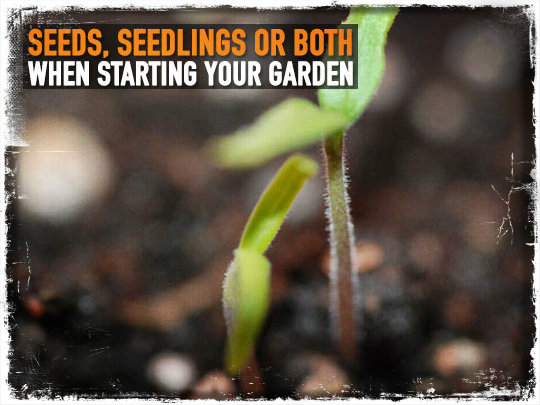
For most people it would be a combination of sowing seeds directly in the ground or in pots and transplanting into the ground using seedlings. The seedlings can be ones that you started yourself indoors six to eight weeks before the last frost, or you can purchase seedlings from your local home and garden store.
Things to Consider
In a survival situation you where you have to start a survival garden, you cannot purchase seedlings from a retail outlet, and you may not be able to start seeds indoors. If the growing season is short certain vegetables may not mature before the first frost, so you have to know before getting started whether the seeds you sow have a chance.
In essence any seed can be started indoors but certain ones do not transplant well. Usually tomatoes, for example, are started indoors because it takes longer for them to mature and they do transplant well. Starting them inside gives you a six to eight week start so you can be assured you would have a crop before first frost if you have a short growing season.
Vegetables that are usually direct seeded include beets, beans, carrots, corn cucumbers, okra, peas, parsnips, turnips, various squash and watermelon, various lettuces and radishes. These vegetables simply do not transplant well, and mature relatively quickly so direct sowing is the best option.
Keep in mind if you do start them indoors vine plants like cucumbers, for example, will require considerable space once they begin to vine.
Plants that transplant well include cabbage, basil, Brussels sprouts, chives, greens such as collard and others, peppers, tomatoes, parsley, cauliflower, celery, eggplant and kale. The list is not comprehensive but includes some of the more common ones.
Other methods include root division and artichokes, for example, can be started this way, while asparagus can be started from roots one year old. Garlic and shallots can be started from the clove. Horseradish can be started from root cuttings while potatoes are started using seed potatoes and in the past farmers simply let some potatoes “go to seed” and then they are stored for next springs’ planting. Rhubarb can be started by planting the root crown. Onions can be grown from seed or sets.
Considerations
To ensure you can survive during an extended crisis you will need to know how to start seeds and transplant certain vegetables in the ground. Plants that can be stated indoors need to be hardened off before they are ready for the ground and this in particularly important when it comes to tomato plants.
Sow the seeds in seed starting soil using small containers, or use seed starting trays that have a plastic lid and peat moss pellets or capsules. The lid keeps the moisture in the soil from evaporating and helps keep the soil warmer.
Once the plants are showing remove the lid and place in sunlight. When the days are warm enough put the plants outside for a few hours at a time once they have developed the third leaf and have been thinned. This will harden them off and will help prevent plants from becoming “leggy” due to insufficient sunlight. Once the fear of frost has passed then you can transplant into the ground or in pots.
Most retail stores right now have seedlings available, and in some cases, they may have some plants more mature. You may be tempted to purchase mature plants now, but remember they cannot be transplanted outside until the fear of frost is gone. If you do buy mature ones they will need plenty of direct sunlight and watering.
Did the retailer leave any plants exposed when the nights were cold? Frost is still a concern in many parts of the country this time of year, and some retailers may leave their plants in the outdoor section unprotected so make you choose carefully if there has been a frost or freeze.
Buying plants all the same size may mean your plants will harvest at the same time. Some of you may prefer to stagger the harvest times to ensure you have fresh produce the entire season. On the other hand you may plan on canning or preserving in some other way, and so you might want your plants to harvest at the same time. Consider what you want and plant accordingly.